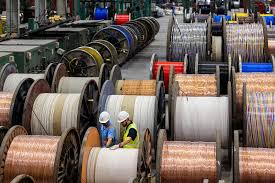The years following 2020 served as a brutal stress test for global supply chains, and the cable manufacturing industry was right in the thick of it. For decades, the mantra was “lean” and “just-in-time” – a finely tuned system designed for maximum efficiency and minimal inventory. But when factory shutdowns, port congestion, shipping container shortages, and geopolitical tensions hit, this hyper-efficient model revealed its fragility. The resulting material shortages, soaring freight costs, and unpredictable lead times forced a critical rethinking. Today, in mid-2025, the new buzzword is resilience. Cable manufacturers are now embracing adaptive supply chain strategies designed not just for efficiency, but for survival and agility in an increasingly uncertain world.
Table of Contents
The Cracks in the “Just-in-Time” Model
The pandemic exposed several key vulnerabilities in the traditional supply chain model for cables:
- Over-reliance on Single Sources: Many manufacturers relied heavily on a single region or even a single supplier for critical raw materials like specific polymer grades or copper. When that source was disrupted, there was no immediate backup.
- Lack of Visibility: Companies often had little real-time insight into their suppliers’ suppliers (Tier 2 and Tier 3), making it impossible to foresee upstream disruptions.
- Fragile Logistics: Dependence on specific shipping lanes and ports created massive bottlenecks when those channels became congested or closed. The logistics challenges felt acutely in hubs like Mumbai highlighted the issue on a local and global scale.
- Lean Inventory Risks: Holding minimal inventory meant there was no buffer to absorb sudden delays, leading directly to production stoppages.
The New Playbook: Building an Adaptive Supply Chain
An adaptive supply chain prioritizes flexibility, visibility, and resilience alongside efficiency. Here are the key strategies cable manufacturers are now implementing:
1. From “Just-in-Time” to “Just-in-Case”
This doesn’t mean wasteful stockpiling, but a smarter approach to inventory.
- Strategic Buffering: Using data analytics to determine optimal safety stock levels for the most critical raw materials and components, providing a buffer against short-term disruptions without tying up excessive capital.
- Multi-Echelon Inventory: Holding inventory at different points in the supply chain (e.g., regional hubs, not just the central factory) to be closer to markets and less reliant on a single point of failure.
2. Diversification: Not Putting All Eggs in One Basket
- Dual/Multi-Sourcing: Actively qualifying and maintaining relationships with multiple suppliers for critical materials, even if one is the primary. This includes building robust partnerships with established suppliers like the quality cable suppliers in uae while also developing alternatives in different geographic regions.
- Geographic Diversification: Moving away from concentrating all sourcing in a single country or region to spread geopolitical and logistical risk. This aligns with national initiatives like “Make in India,” encouraging domestic sourcing where feasible.
3. Nearshoring and Regionalization
- Shortening the Chain: Instead of sourcing from halfway across the world, some manufacturers are looking to bring their supply chains closer to home (“nearshoring”) or creating regional supply networks to serve regional markets.
- Benefits: This reduces transportation times and costs, lowers exposure to international shipping disruptions, and can improve responsiveness to local customer demands. It enhances the value proposition of regional leaders like prominent cable manufacturers in uae serving the Middle East and surrounding areas.
4. Deep Digital Visibility
- Investing in Technology: Implementing advanced supply chain visibility platforms that use IoT, blockchain, and AI to provide real-time tracking of shipments and materials across the entire chain.
- Collaborative Platforms: Using shared digital platforms to improve communication and transparency with suppliers and logistics partners, allowing for faster response to potential issues.
- Predictive Analytics: Using AI to analyze data from multiple sources (shipping data, weather, port congestion reports, news) to predict potential disruptions and allow for proactive rerouting or planning.
5. Building Stronger, More Collaborative Supplier Relationships
- Beyond Price: Shifting from purely transactional relationships to true partnerships with key suppliers. This involves greater transparency, joint planning, and collaborative risk management.
- Supplier Development: Working with suppliers to help them become more resilient and efficient, which in turn benefits the entire supply chain.
What This Looks Like in Practice
An adaptive cable manufacturer in 2025 might have a supply chain that:
- Maintains a 4-week buffer stock of a critical polymer from its primary Asian supplier.
- Has a fully qualified secondary supplier for that same polymer based in Europe.
- Uses a real-time visibility platform to track the container ship carrying its copper shipment.
- Receives an AI-powered alert that its shipment’s destination port is experiencing high congestion and automatically models the cost/time impact of rerouting to a nearby port.
- Fulfills a large order for the Indian domestic market using materials sourced from local Indian suppliers to reduce lead times.
Conclusion: Building for Agility and Resilience
The post-pandemic era has taught the cable manufacturing industry a crucial lesson: efficiency without resilience is a fragile victory. The future belongs to those with adaptive supply chains that can bend without breaking. By embracing strategies like strategic inventory buffering, supplier diversification, regionalization, deep digital visibility, and true partner collaboration, cable manufacturers can build the robust and agile operations needed to navigate future disruptions, manage risks effectively, and reliably deliver the vital connections our world depends on.
Your Adaptive Supply Chain Questions Answered (FAQs)
- Does “adaptive supply chain” mean the end of “lean” or “just-in-time”?
Not entirely. It’s more of an evolution. The goal isn’t to be wasteful but to inject flexibility and resilience into the lean model. Companies will still strive for efficiency but will balance it with strategic inventory (“just-in-case”) and diversified sourcing to mitigate risk, creating a “lean but resilient” hybrid. - Is nearshoring or regionalization a major trend in the cable industry?
It is a growing consideration. While global sourcing for many raw materials remains essential due to cost and availability, there is a clear trend towards setting up manufacturing and supply hubs closer to major customer markets to reduce logistics complexity and lead times, especially for high-volume or custom products. - How does technology like AI help in creating an adaptive supply chain?
AI is a powerful tool for this. It can analyze vast amounts of complex data to provide:
- More Accurate Demand Forecasts: Reducing inventory errors.
- Predictive Risk Alerts: Warning of potential shipping delays, port congestion, or weather impacts.
- Optimized Routing: Suggesting the best shipping routes in real-time.
- Inventory Optimization: Calculating the ideal safety stock levels for thousands of different materials.
- What is a Tier 2 or Tier 3 supplier?
A Tier 1 supplier is a company you buy from directly (e.g., the supplier of a polymer compound). A Tier 2 supplier is your supplier’s supplier (e.g., the chemical company that provides a specific additive to the polymer compounder). A Tier 3 supplier provides materials to the Tier 2 supplier. The pandemic highlighted that a disruption at a Tier 2 or 3 level can halt the entire chain, making visibility into these deeper tiers important.
How can smaller cable manufacturers afford to build adaptive supply chains?
Smaller manufacturers can start with targeted strategies. They might not be able to build global regional hubs, but they can focus on qualifying at least one backup supplier for their most critical materials, building stronger communication channels with their key logistics partners, using more accessible cloud-based software for better inventory visibility, and holding a small, strategic safety stock of key components.

